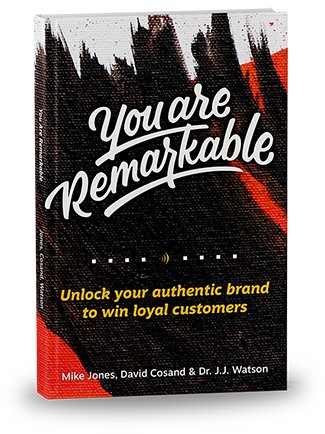Businesses are famous for believing lies about themselves. The SWOT analysis, rigorously done, will serve to disabuse you of misconceptions that could be costing you money and opportunity.
How do businesses deceive themselves? By using bad data (they don’t always talk to customer, and when they do, they often don’t ask the right questions) and good ol’ fashion failure to think things through.
Note: This is the first post in a blog series that will unpack the four basic steps of creative strategy. Leave one step out, and you’ve left out an essential building block of creative strategy.
Businesses Deceive Themselves
Without good data and the ability to proportion that data to create a clearer view of the competitive landscape, businesses become very good at deceiving themselves. Before we move on to the SWOT analysis (the first step in the creation of any good creative strategy), let’s talk about two major problems in strategy.
Problem 1: Bad Data
Although we’ll address research in a future article within this series, it’s worth pointing out that, in one survey, 80% of business leaders believed that they delivered “superior service.” But when the researchers posed the question to customers, only 8% believed they received superior service. The businesses weren’t off by 10% or 15%. They were off a full 900%.
Problem 2: Uncoordinated Knowledge
Let’s say your company talk about speed, but nothing you have listed as an “opportunity” is relevant to speed. Or maybe you have “speed” listed as both a strength and a weakness. Or maybe you have “speed” listed as
Why the SWOT Matters
Cataloging and coordinating knowledge and then organizing it toward a goal serves to cleanse your organization of false and potentially damaging assumptions.
When you do a SWOT analysis with other people, you’re forced to do what philosophers do: test definitions.
Testing definitions and organizing principles (e.g. products, competencies, roadblocks) in a logical way helps you to find focus, even when you lack reliable data. Furthermore, it helps inform your future research questions.
Done well, this pushes you deeper into understanding. Done lazily, it just tells you the obvious. So let’s think about how to do it well.
Using the SWOT
The SWOT is useless unless you know a few things:
- It’s meant to be reductive. If you have a bunch of strengths when you’re done, that’s a bad thing.
- It’s coordinated.
- Strengths that don’t serve one of the listed opportunities don’t matter. Use opportunities to cross out irrelevant strengths. Same thing with weaknesses that don’t matter.
- Weaknesses get broken down into two categories: weaknesses that we’re okay with and weaknesses we’ll make plans to change. Make sure to decide where each weakness falls, so you can deal with it accordingly.
- Weaknesses that are also listed as strengths just need to be defined better. So if “quality” is a strength and a weakness, talk about what kind quality you mean.
- Can you turn strengths into verbs? In other words, if you say “quality” is a strength, what do you do to realize that quality? If you can’t do that, be suspicious of those “strengths.”
- Do you end up with threats/competitors that have strengths that are the same as one of your strengths, and they’re actually better than you at it? Cross it off. If it’s a strength, but your competition is better at it, it’s their strength, not yours.
- Do “opportunities” turn into usable client problems? Even better: can they start to tell you who your audience profile/persona is?
Decide the scope of the SWOT
Remember that a SWOT is a tool to help you find your comparative advantage. It’s a term that’s a little more specific than “competitive” advantage.
David Ricardo, an economist, realized that you could be not quite as good at something as someone else, but still have a comparative advantage. Michael Jordan may have been the fastest typist in the world, but since he makes so much money playing basketball, he’d lose a ton of cash if he switched. So even though he might be better at it, the second-best typist might have a huge “comparative” advantage because of their lower opportunity cost.
So, you’re not trying to find what you’re best at. You’re really trying to find your lowest opportunity cost.
Click here for more on comparative advantage versus absolute advantage.
That’s why we quickly abandon “strengths” that our competition is better at. But there’s no way to arrive at these strengths unless we know the scope. In other words, we have to constrain the scope of the SWOT analysis, so we know exactly what we’re analyzing.
- Is it a product?
- Is it a service?
- Is it a strength within your organization, such as: operations, project management, or marketing?
Narrow your SWOT
In the “opportunities” sections, shoot for only three. If those opportunities are three needs, awesome. If you can get them down to three audience profiles/personas, even better. Then test and rank.
- Why would these audiences you’ve listed go with the competition?
- Do you have any weaknesses that nullify your ability to deliver to those audiences that represent your biggest opportunities?
- What strength of your brand or product will resonate most with each audience?
- Why does your product or brand matter in their lives?
- Rank them. This allows you to prioritize your budget, starting with your lowest-hanging (and most profitable) fruit.
Want your marketing budget to work hard? Prioritize.
Don’t leave your SWOT in the form of a bullet list. Instead, do the hard work of prioritizing. You need one compelling argument on which to focus. And everyone who hears about you hears that one compelling argument. They know for sure that’s what you stand for.
Prioritizing makes your marketing money work the hardest.
If you offer quality customer service, then ONLY TALK ABOUT THAT. Don’t distract your audience by claiming more things.
Decide on your comparative advantage
The SWOT analysis is a simple, flexible tool. This usually means it’s difficult to use without skill and discipline. But if it’s focused right, it becomes a magnifying glass, cutting through the clutter and focusing you on what really matters to your success.
Once you become focused, you’re ready for the next step: turning that focused offering into a message that inspires action on the part of your audience. So stay tuned for the next section, where we talk about what kind of message to deliver (with some help from Abraham Maslow).
In the meantime, join us at the next brand workshop where we’ll help you rebrand in the spirit of accuracy and clear thinking we talked about here.



